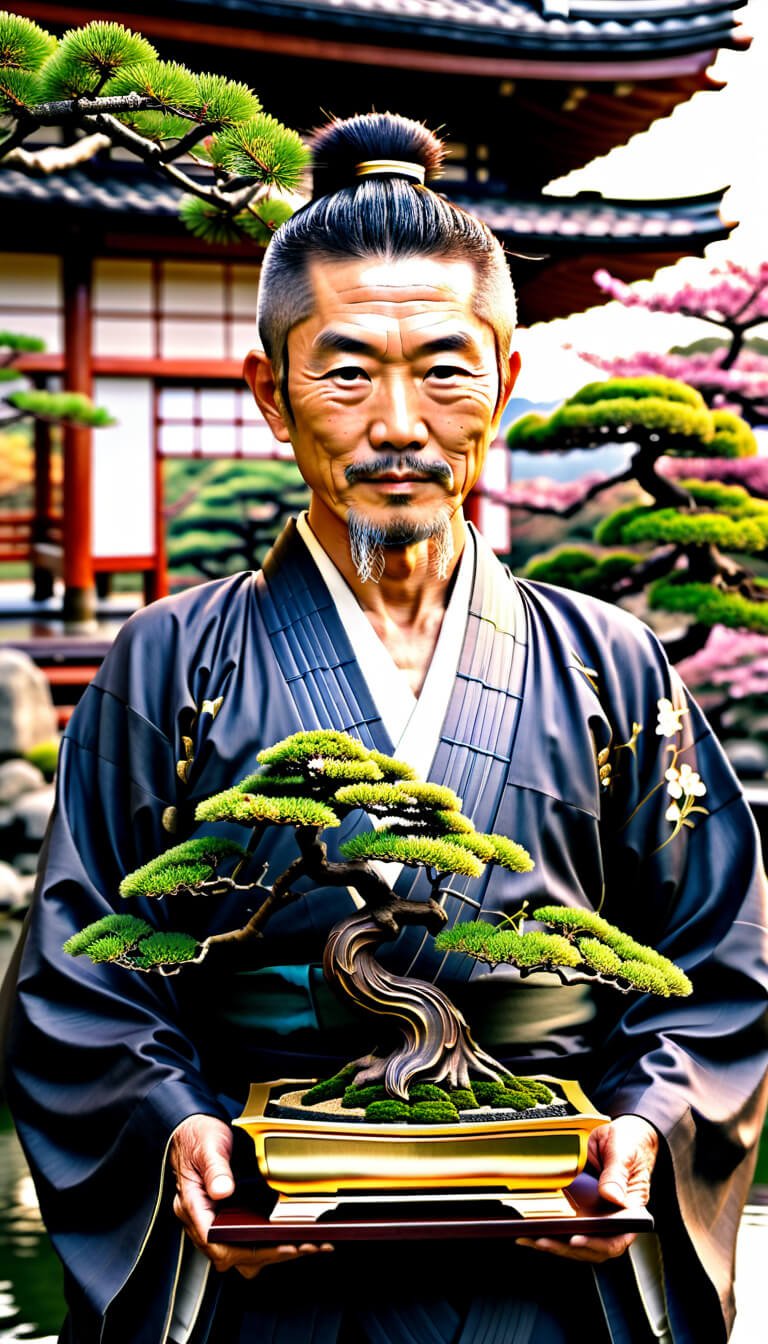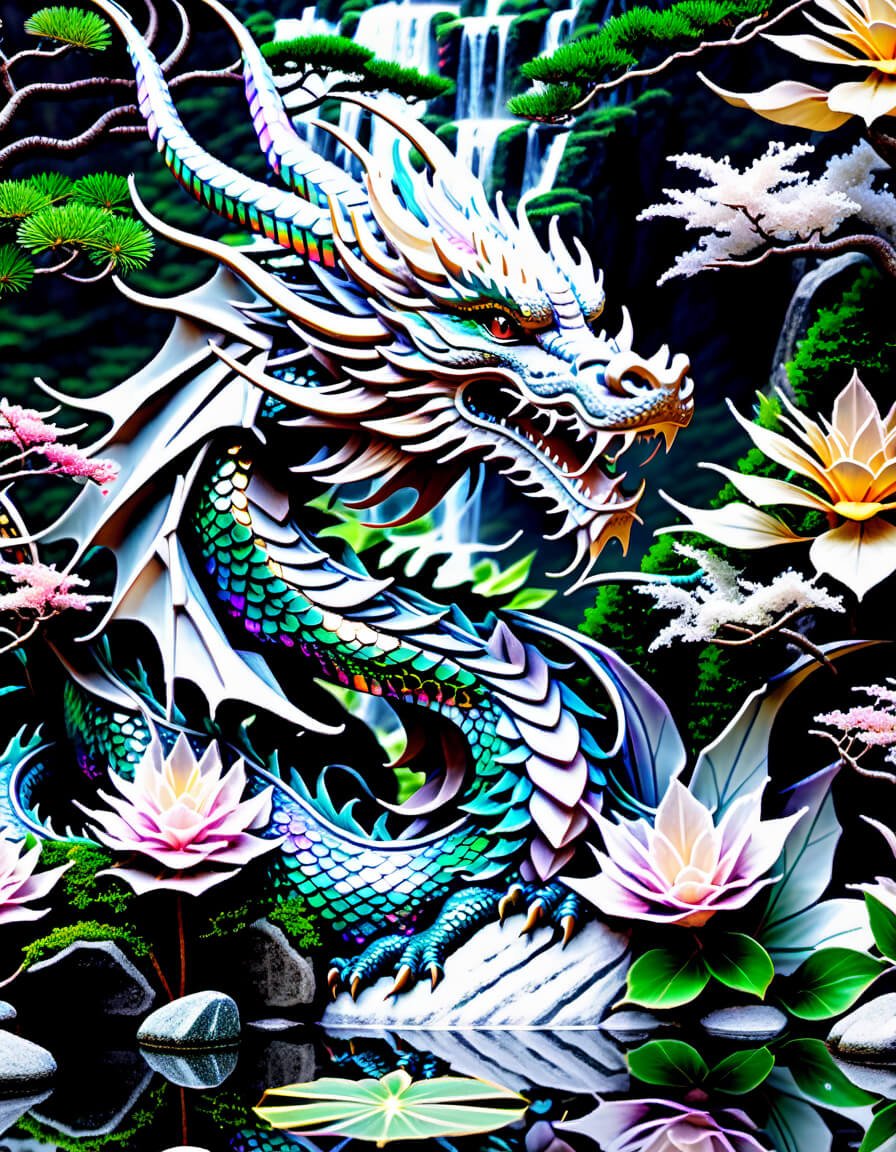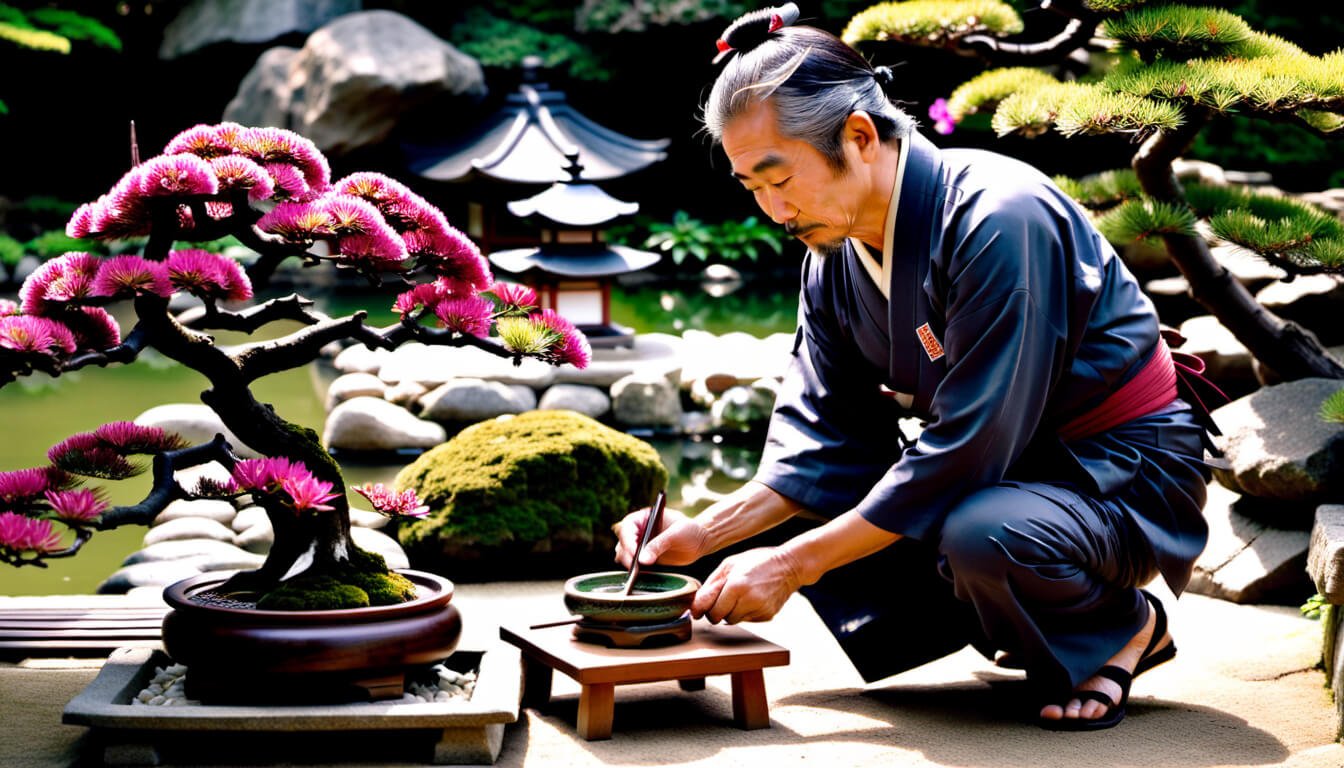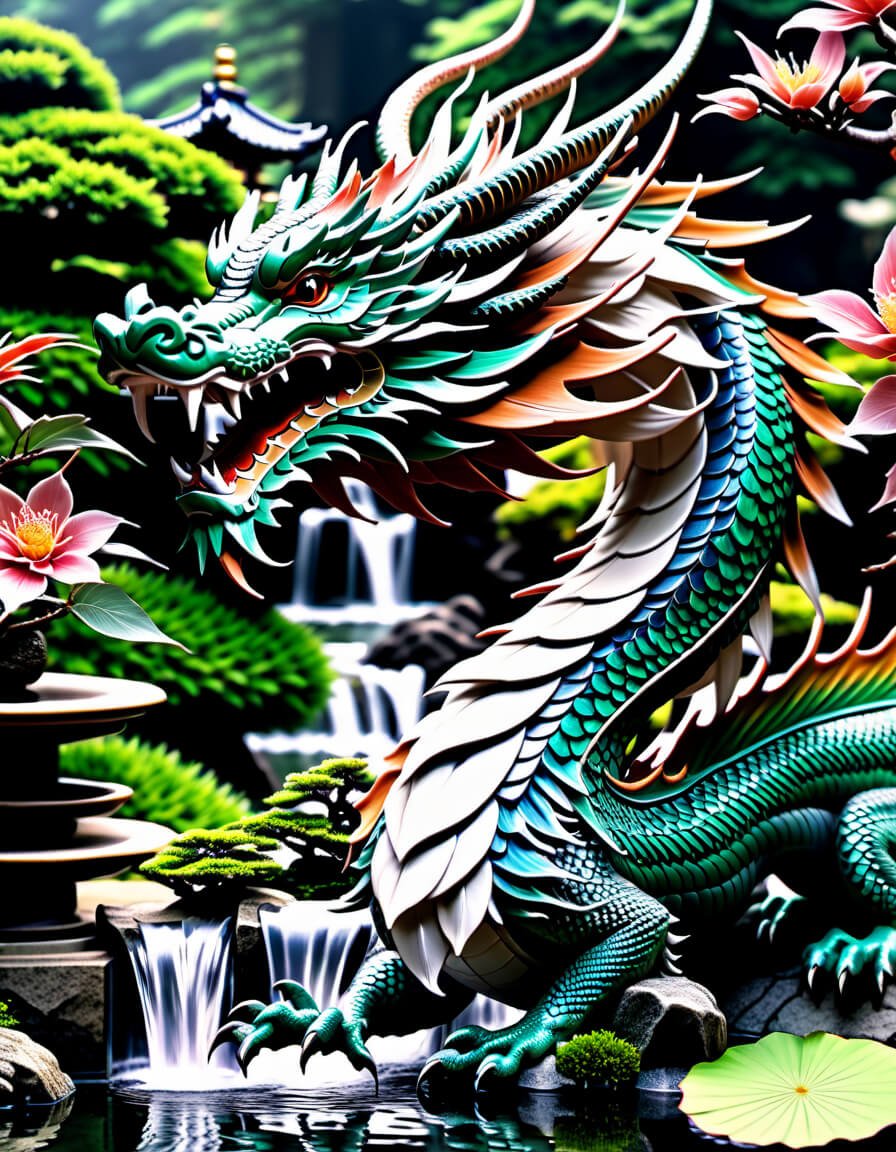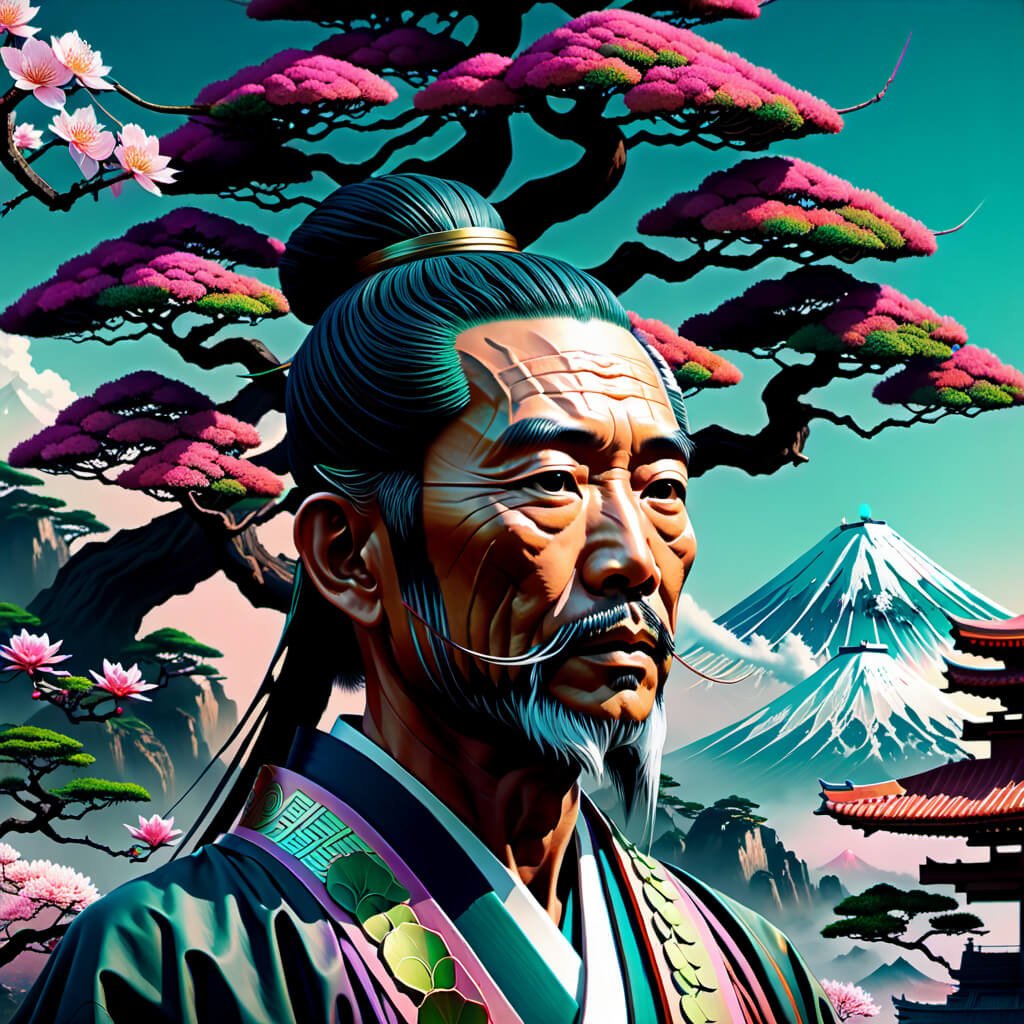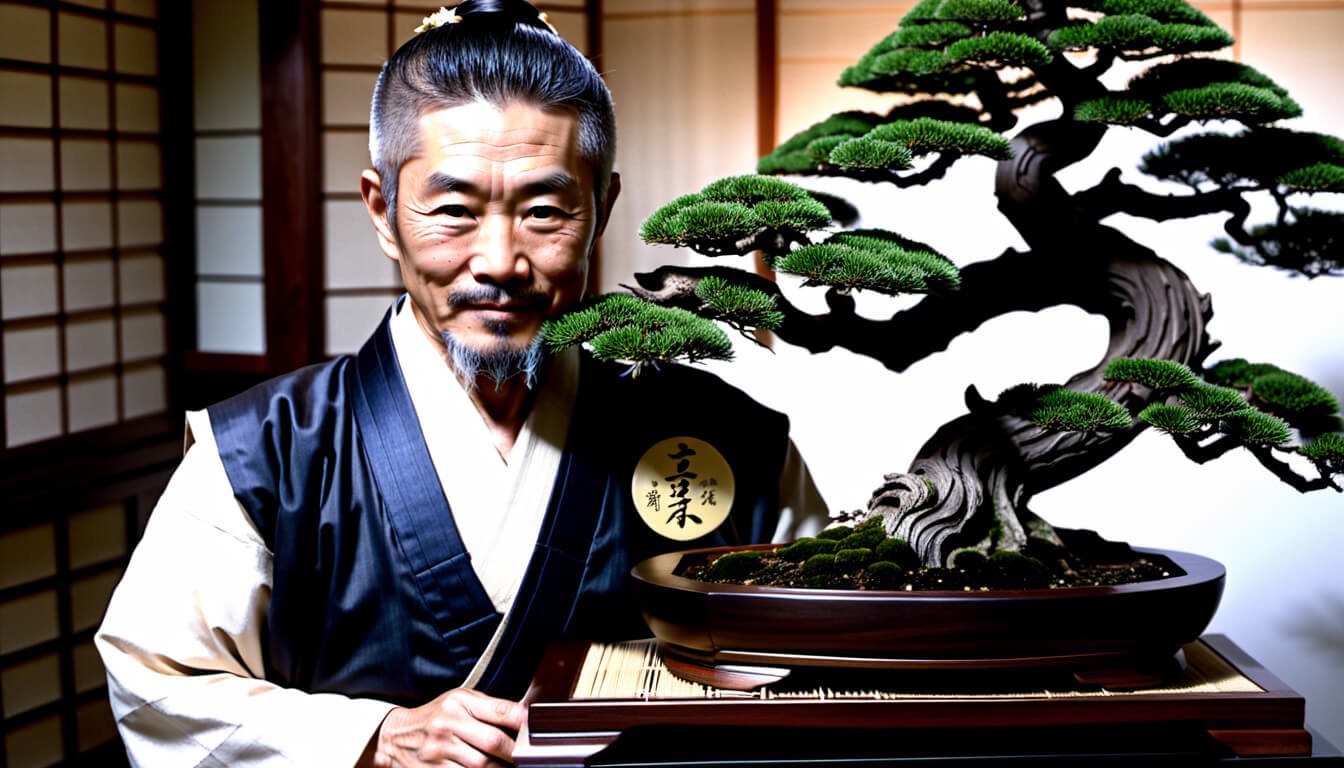Art of Bonsai: Spirituality, Ecology, Global Appreciation
Tracing the ancient art of bonsai from origins in China through evolution in Japan, explore how cultivating miniature trees in containers bridges spirituality and sustainability, inspiring ecological consciousness.
Art of Bonsai: Spirituality, Ecology, Global Appreciation, Stunning Japanese Bonsai Specimen with Miniature Waterfalls and Pagodas, Hasselbad 501C
Summary
Bonsai originated in ancient China and evolved as an art form in Japan, blending spiritual and aesthetic ideals.
Renowned masters established techniques still used to shape miniatures that encapsulate nature.
Contemporary bonsai specimens attained global fame for proportion and weathered character.
Notable public and private bonsai collections preserve and display diverse masterworks.
Japanese Bonsai Master Poses with his Prized Specimen, Ancient Art of Bonsai is a Sacred Japanese Art that Blends Creativity with Deep Ecological Wisdom
As an iconic tradition, bonsai bridges human creativity with ecological balance. Bonsai, the ancient East Asian art of artistically growing miniature trees in containers, has become a globally recognized and admired tradition. The origins of bonsai can be traced back over a thousand years to ancient China, where early techniques of cultivating plants in containers emerged. However, it was in Japan where these methods truly evolved into an art form infused with spiritual meaning and a profound appreciation for nature (Yu, 2022).
The bonsai tradition epitomizes core elements of traditional Japanese aesthetics and worldviews. With its meditative practices, emphasis on patience and discipline, and ability to capture the essence of nature in miniature, bonsai bridges spirituality, ecology, and an international appreciation of Japanese culture. An exploration of the history of bonsai, including its connections to Chan Buddhism, its role in representing Japanese ideas about nature, and the status of bonsai as a globally admired Japanese art form provides insight into what this unique tradition can teach about perceiving nature and cultivating harmony between humans and their environment.
Eternal Gaze of Sukeyori, Surreal Portrait of Ancient Japanese Bonsai Artist
Early History and Buddhist Influences
While primitive forms of growing plants in containers appeared in China over a thousand years ago, it was in Japan where these techniques truly transformed into an art form. After the introduction of Chan (Zen) Buddhism to Japan in the 12th century, monks began bringing back pottedplants from China to decorate temple gardens (Nippon Bonsai Association, 2022). These early attempts at containing nature in pots lacked formalized techniques, but they set the foundation for what would become a revered art form among elite members of society.
As Yu (2022) discusses, it was during the Edo period in Japan (1603-1868) when bonsai began taking shape as a unique discipline interweaving components of Chan Buddhist beliefs and Daoist principles. Buddhist monks and scholars During this era, learned individuals would compete with each other by artistically arranging stones, plants, and flowers to create miniature representations of natural scenes (Yu, 2022). The meditative and discipline-focused nature of this practice aligned with Chan Buddhist emphases on attaining enlightenment through mastering one's craft. As bonsai techniques became more refined over generations, the practice also took on the Daoist view of discovering profundity within simplicity, with just a single plant contained within a pot reflecting the vast complexity of the natural environment.
These Buddhist and Daoist underpinnings continue to infuse the practice of bonsai today. While largely secularized, caring for bonsai still requires tremendous patience, discipline, and an aesthetic envisioning of how to shape living plants into artistic forms. As Chan Buddhist monk and bonsai master Itō observes, "Through bonsai we learn concentration, and the fruit of concentration is enlightenment" (Hubbard & Swartz, 2022, p. 144). This meditative feature connects bonsai practice to the Buddhist search for spiritual awakening.
Princess of the Jeweled Lotus, Esoteric Portrait Celebrating Ancient Japanese Garden Arts and Timeless Beauty
Representing Nature Through Miniaturization
In addition to Buddhist influences, bonsai practice also epitomizes core Japanese cultural views about apprehending nature. As Treat (2022) observes, the Japanese concept of miniaturization has long played a key role in Japanese aesthetic traditions as a means of artistically representing and contemplating environments far larger than oneself. Japanese gardening practices, floral arrangements, and pottery frequently incorporate small-scale designs not merely for decorative purposes but to reflect the Japanese cultural admiration of nature's vastness.
Bonsai carries on this tradition of using miniaturization to artistically replicate natural scenery. The practice of cultivating miniature trees in containers follows the Zen Buddhist idea that single leaves can reflect the beauty of entire landscapes, if properly perceived (Hubbard & Swartz, 2022). Through techniques like pruning, wiring branches, carving deadwood, and artistically placing plants on rock landscapes within containers, bonsai seeks to capture the very essence of nature within a microcosm, reflecting Japanese cultural views of finding enlightenment by discovering the universe within small details.
As Treat (2022) describes, "Bonsai miniaturization echoes the Japanese feeling of nature's enormity and seeks to understand it by recreating powerful natural designs writ small...the transmutation of the macrocosm into microcosm" (p. 58). By shaping miniature environmental scenes, the art of bonsai provides a window into traditional Japanese ways of artistically perceiving and replicatingthe natural world.
Bonsai Paradise in Japan
Influential Ancient Masters and Texts
Although bonsai originated in China then evolved in Japan, few early practitioners are known by name. However, texts and treatises from past masters established guidelines still followed today. For example, the epic 12th century manuscript Sakuteiki outlines aesthetic and horticultural principles for garden design along with container plantings, while the Samurai Sukeyori’s 14th century Album of Plants and Flowers features one of the earliest known depictions of a dwarfed potted tree (Zhao, 2022).
Several centuries later during bonsai’s development as a contemplative art form, the renowned 18th century monk and artist Sengai Gibon became one of the first recognized master shapers of dwarfed trees, demonstrating a mastery of visual balance (Hubbard & Swartz, 2022). Alongside other scholar-artists like Bunjinga and Nangaku, he elevated bonsai into an object of prestige. These early practitioners began establishing formal techniques for inducing miniature proportions while conveying an aged, weathered look suggesting perseverance through hardship.
Modern specimen trees still reflect seminal designs by early innovators. For example, the driftwood bonsai style seen today traces back to the 18th century master Tokugyoku, who pioneered shaping branches around dead wood elements (Nippon Bonsai Association, 2022). Through documenting such formats in manuals and treatises, along with demonstrating aesthetic principles, early masters formalized techniques still admired today.
Jaw Dropping Bonsai Display Next to a Waterfall
Renowned Contemporary Specimens as Exemplars
Just as historical texts established prototypical styles, certain contemporary bonsai specimens have attained celebrity status as paragons of the art form. Several traits characterize specimens selected for top honors at global exhibitions, including proportion, balance, vitality despite simulated age, and a transcendent, even otherworldly presence (Treat, 2022).
Certain individual trees have even taken on proper names in acknowledgment of their sublime exemplification of bonsai ideals. These named specimens rank among the most celebrated in international circles. For example, the exquisitely proportioned Japanese white pine Chabo Hiba took first place in the 2005 and 2007 Sakufu Bonsai Exhibitions, the highest honors for living masterpieces. With wide-spreading yet delicate branches befitting its great age, Chabo Hiba represents a feminine grace and tranquility sought after in many bonsai (Nippon Bonsai Association, 2022).
Meanwhile, the ominously named dragon bonsai tree Ryunoken was sculpted over 80 years into a powerful, aged specimen alluding to supernatural qualities, encapsulating the human ability to discover mythical elements within nature (Magical Bonsai, 2022). These named plants stand alongside other celebrity specimens as embodying certain aesthetic and spiritual aspirations of the art. While few practitioners will ever attain their level of mastery, famous bonsai trees set aspirational standards for the potential of the art form at its peak.
Majestic Crystal Dragon Placed in a Japanese Garden
Notable Public and Private Collections
In addition to following the example set by ancient patriarchs and modern exemplars, enthusiasts also visit eminent bonsai collections to admire numerous specimens representing the diversity of the art form. Certain collections have attained special notoriety as premiere conserved displays of masterworks.
For example, Japan hosts several famed public exhibitions, including the Omiya Bonsai Village which features a revered “Bonsai Mecca” garden showcasing diverse species year-round. Complementing this public collection are esteemed private collections built through generations, including the acclaimed Obuse Kokofu Bonsai Museum with centuries-old trees on rotating display (Hubbard & Swartz, 2022). Such personal collections laboriously compiled by dedicated individuals give insight into bonsai as a lifelong creative passion.
In Europe, prominent collections include Italy’s Crespi Bonsai Museum with rare specimens like an estimated thousand-year-old Taiwanese juniper. Switzerland’s Bonsai SambaItalia Garden also contains beloved specimens passed down through generations of caretakers (Magical Bonsai, 2022). These European collections play a vital role in preserving and showcasing extraregional styles for international audiences.
In contemporary times with the global spread of bonsai appreciation, collections large and small have emerged across continents and cultures. Major international exhibitions now convene for enthusiasts to display diverse specimens representing local varieties, showing bonsai as an ongoing celebration of nature’s endlessly differentiated forms. Ranging from historical relics of the art form to new interpretations yet to undergo heritage, global bonsai collections reflect the living vitality of an ancient tradition intersecting past, present, and future.
Mysteries of the Jeweled Lotus, Esoteric Goddess Portrait inspired by Japanese Garden Arts
Esteemed Species
While nearly any small woody species can become bonsai, certain tree varieties have proven especially suited for miniaturization into specimens exuding aged character. Classic choices praised through generations include the Japanese white pine with its rugged texture, the Chinese juniper’s extensive styling adaptability, along with hardy maples and oaks offering autumn foliage (Nippon Bonsai Association, 2022).
However, beyond commonly acknowledged selections, aficionados also extol unique regional varieties like Australia’s desert-dwelling candlestick banksia with its distinctive serrated leaves and alluring flowers. Rainforest dwellers like Tasmania’s myrtle-beech also intrigue through cool weather adaptations in a dwarfed bonsai form. Following the global spread of bonsai appreciation, enthusiasts now experiment with miniature versions of diverse botanical treasures, celebrating regional diversity through living art (Bonsai Outlet, 2022).
Through ancient wisdom passed down from early innovators, extreme technical prowess by renowned modern shapers, along with the abundant diversity sustained in collections and species worldwide, bonsai continues progressing as a pinnacle botanical art form spanning cultures and eras to distill nature’s glory into miniature perfection. The living legacy of bonsai nourishes connoisseurship while pushing aesthetic possibilities ever forward through its embodiment of creative adaptation within constraints, persistence against adversity, and the ageless appeal of discovering epic grandeur within small wonders.
Ancient Bonsai Master Surreal Digital Vapor Dream
Cultivating Harmony Between Humans and Nature
In addition to influencing Japanese aesthetics and worldviews, the practice of bonsai also promotes an ecological consciousness centered on cultivating balance within environments. As Horiuchi (1997) observes, the intensive demands of caring for bonsai, including regulating soil components, moisture, sunlight exposure, and pruning practices forces practitioners to attune themselves to the intricate needs of natural systems. Fostering the fragile health of small plants over decades or even centuries requires tremendous empirical knowledge, passed down across generations, about how to maintain harmony between organisms and their living contexts.
As a result, bonsai practice instills an ecological awareness where humans take active responsibility for cultivated balance within local environments, rather than dominating unchecked over nature (Horiuchi, 1997). This promotes a sustainable worldview valuing longevity and stable continuity betweenliving systems. While originating before modern environmentalist perspectives, bonsai suggests traditional wisdom about strike a balance where human activities enhance rather than diminish plant vitality. As Horiuchi describes, the empathy and discipline required provides "training as a human being" about one's position within natural environments (1997, p. 14).
The practices passed down by bonsai masters over centuries can therefore inform modern ecological awareness. In an era concerned about human impacts on climate change and sustainability, bonsai represents ancient knowledge about how disciplined human interventions into local environments can foster new forms of beauty rather than destruction when conducted with empathy, patience, and an orientation towards stability. The intricate pruning and watering techniques traditional to bonsai provide inspiration for how human actions might integrate harmoniously and supportively within natural systems, cultivating balance through skill rather than domination through imposition.
Award-Winning Bonsai Garden
Global Recognition as a Japanese Cultural Tradition
While emerging from Chinese precursors, bonsai became refined into an art form of global admiration through Japanese influences infusing spirituality, aesthetic ideals, and ecological balance into the painstaking cultivation of miniature trees within containers. Today bonsai stands as one of Japan's most iconic living art forms, symbolizing key elements of Japan's cultural traditions.
As Treat describes, the international spread of bonsai artistry displays clear signs of arising uniquely from Japanese culture:
The trend toward display of bonsai at exhibitions, the organization of clubs for collector aficionados of the art, the commodification of tiny specimens along with their containers and tools in lively bonsai marketplaces notably in venues outside Japan, all marked bonsai culture as a particularly Japanese art and its global spread as part of the larger boom in Japanese culture abroad. (2022, p. 58)
Major bonsai exhibitions now take place across Asia, Europe, and the Americas, further cementing bonsai as a quintessentially Japanese art form valued for its meditative qualities and aesthetic interpretations of nature.
This global appreciation and recognition of bonsai represents an embrace of core elements of Japanese culture and spiritual connections with the environment. As Treat (2022) describes, the international admiration for bonsai signifies the export of Japan's unique spirituality grounded in nature: "bonsai culture disseminated Zen Buddhism aesthetics about nature to global audiences" (p. 58). The globalspread of Japanese bonsai reflects an intercultural appreciation of Japan's tradition of cultivating miniature environmental scenes as a catalyst for patience, tranquility, and envisioning nature's boundless complexity within single leaves.
The refined art of bonsai originated in Japan over a thousand years ago as a crystallization of Chinese planting techniques into a unique practice integrating components of Chan Buddhism, Daoism, and Japanese admiration of nature's sublime qualities. Through its emphasis on discipline, meditation, and revealing enlightenment within single contained plants, bonsai bridges human spirituality with an aesthetic interpretation and ecological cultivation of natural environments.
The global admiration for this distinctly Japanese art form signifies the intercultural spread of Japanese ways of connecting to nature. As a bridge between spiritual reflections and environmental harmony, the living legacy of bonsai offers inspiration about cultivating balance, sustainability, and new forms of beauty within local natural contexts through human actions undertaken with empathy and patience.
Ancient Japanese Princess of the Jeweled Lotus Holds a Fluorite Crystal, Esoteric Portrait
Bonsai Origins in China and Evolution in Japan Through Cultural Synthesis
While Japan is credited with elevating the cultivation of artistically shaped miniature trees into an revered art form, the origins of growing plants in containers can be traced to ancient China. As Yu (2022) outlines, primitive precursors to bonsai appeared during China's Tang Dynasty (618-907 CE), where palace gardens incorporated early techniques of growing plants in pots. However, these initial attempts lacked the refined techniques and spiritual orientations associated with later Japanese bonsai traditions. It was only through centuries of cultural fusion that the aesthetic and contemplative depths of bonsai fully materialized.
Japanese Bonsai Artist Focuses Intensely on His Prized Specimen
Early Chinese Precursors
References to rudimentary Chinese planting techniques that foreshadowed the development of bonsai date back over one thousand years. As Zhao (2022) describes, China's Tang Dynasty featured some of the earliest known instances of deliberate dwarfing techniques and growing miniature aesthetic plants in containers. Palace gardens incorporated potted plants as ornaments, drawing inspiration from myths about magical dwarfed trees containing spiritual properties.
However, as Yu (2022) analyzes, these preliminary Chinese potted plant cultivation practices differed considerably from what later crystallized as bonsai techniques in Japan. Early Chinese stoneware containers lacked drainage holes, preventing regulated watering. Furthermore, plantation methods focused primarily on stunting growth rather than careful pruning or shaping to represent natural scenery (Zhao, 2022). These initial attempts set some groundwork but lacked the refined techniques, aesthetic orientations, and contemplative spiritual dimensions of Japanese bonsai.
Legend of Doragon, Japanese Dragon Guards a Lush Multi Tiered Japanese Bonsai Paradise
Transmission to Japan Through Buddhist Exchange
It was through the transmission of Chan (Zen) Buddhism to Japan that preliminary techniques and fascinations with potted plants made their way to Japan from China. As the Nippon Bonsai Association (2022) documents, Buddhist monks studying Tang Dynasty Chan Buddhism brought back small potted plants to decorate 12th century Japanese temple gardens, sparking interest among the aristocracy. These simple potted plants lacked developed aesthetic details, but they attracted the curiosity of Japanese monks, scholars, and nobles through their connection to Chinese Buddhism.
This transmission initiated a period of cultural exchange where rudimentary Chinese planting techniques intermixed with Japanese sensibilities, setting the foundations for bonsai. As Treat (2022) observes, the arrival of these miniature plants from China "gained esteem in Japan from their hold on the Zen Buddhist imagination and participation in the larger Chinese cultural imports of the medieval era" (p. 58). While lacking refinement, these potted plants mediated an exchange between Chinese and Japanese culture, helping spur interest through Buddhist affiliations.
Princess of the Jeweled Lotus, Surreal Hyperdimensional Japanese Goddess of the Garden Arts
Refinement Through Japanese Aesthetics and Spirituality
Over subsequent centuries, building on the Chan Buddhist reception of simple Chinese potted plants, Japanese tastes, orientations, and techniques transformed planting dwarfed trees in containers into a revered art form. The Edo Period saw noted scholars begin experimenting through cultivating miniature potted landscapes, blending Chinese horticultural knowledge with Japanese aesthetic orientations (Nippon Bonsai Association, 2022). This refinement involved developing techniques like leaf pruning, grafting, and branch shaping to replicate natural scenery in miniature dimensions.
New spiritual dimensions also emerged, with bonsai practice adopting meditation techniques, viewing small trees as encapsulating boundless natural complexity (Treat, 2022). As Yu (2022) summarizes, "It was only during the later Edo Period that dwarf potted trees began their stylistic and technical evolution into bonsai" through integrating Chinese knowledge of stunting growth with Japanese interests in miniaturization and Buddhist meditative ritual (p. 48). Building on religious affinities from China, bonsai took on increased spiritual associations in Japan for cultivating tranquility, discipline, and an aesthetic window into nature's vast essence.
Through generations of cultural exchange and refinement, bonsai ultimately crystallized in Japan as merging Chinese precursor dwarfed potted plants with Japanese spiritual, aesthetic, and technical orientations. Blending Buddhism with Daoism, bonsai practice took on increased associations with meditative ritual, discovering profound tranquility through cultivating balance within small spaces. As Treat observes, "the Japanese elaboration of Chinese container plantings into a full-fledged art form was unmistakably infused with Japanese religious aesthetics" (p. 58). By integrating foreign knowledge with local orientations, Japan elevated simple decorative potted plants into a globally iconic art form reflecting Japanese worldviews.
Legend of the Ancient Art of Bonsai, Surreal Portrait of a Bonsai Master in Ancient Japan, Vapor Dream
Evolution of Bonsai Traditions Across Eras and Cultures
Bonsai has progressed through phases of early experimentation, refinement as a contemplative art form, global transmission, and ultimately international celebration as a bonsai art movement. Tracing developments in bonsai provides insight into how miniature tree cultivation transformed from rudimentary plant dwarfing techniques into an esteemed living art form interweaving spirituality and nature appreciation.
Ancient Japanese Priestess of the Jeweled Lotus in Deep Meditation, Esoteric Portrait
Early Origins in China (c. 600 CE - 900 CE)
Earliest known miniature potted landscapes appear in ancient China during the Tang Dynasty, known as penjing. These primitive plantings in containers lack advanced techniques but introduce idea of dwarfing trees and shrubs for aesthetic purposes.
Chinese penjing gardening establishes early aesthetic framework valuing asymmetry and irregularity as reflecting nature’s organic beauty. These initial guidelines later influence Japanese bonsai perspectives.
Dwarfing potted trees transition from exclusive palace gardens into homes of elite scholars and aristocrats by late Tang era, spreading interest. However, plantation methods remain rudimentary compared to later bonsai refinement.
Bless the Sacred Doragon, Majestic Japanese Dragon (Doragon) Protects a Bonsai Garden in Japan
Transmission to Japan (c. 1200 CE - 1400 CE)
Zen Buddhist monks studying in China introduce concept of potted miniature tree landscapes to Japan after 12th century. These early specimens lack developed styles but retain religious and scholarly interest.
Plantings of Chinese potted trees kickstart era of experimentation and adaptation toward Japanese aesthetic preferences for contemplative disciplines reflecting nature.
Influential 14th century scroll painting Album of Flowers and Trees features early known depiction of dwarfed potted tree in Japan, suggesting elite interest.
Deep Ecological Wisdom Embodied by the Masters of the Ancient Tradition of Bonsai. Hyperdimensional Portrait of an Ancient Sage
Formative Era of Bonsai (c. 1550 CE - 1800 CE)
With the beginning of Japan’s Edo Period, bonsai undergoes first flourishing due to interest among scholars, monks, and aristocrats. Early varieties replicate natural mountain and forest scenes in miniature.
Many baseline aesthetic principles become codified, including miniaturization for contemplation, irregularity and asymmetry representing naturalness, along with principles for inducing aged appearances.
Early specimens display predominantly fuller silhouettes with focus on shaping branches and foliage. Minimalist styles prioritizing exposed trunks and branches have not yet emerged.
Tokugyoku pioneers new driftwood sculpting bonsai style, establishing aesthetic appeal of dry deadwood mixed with living branches, which later spreads.
Japanese Princess of the Jeweled Lotus, Surreal Digital Oil Painting
Maturation Into Contemplative Practice (c. 1800 CE - 1900 CE)
Through late Edo era, bonsai becomes established as a refined art form among Japanese cultural elite. Growing specialization of techniques and styles emerges.
Bonsai is cemented as a contemplative discipline reflecting spirituality, harmony with nature, concentration, and revelation of the essential within the miniature. Practitioners extol aesthetic and meditative virtues.
Intricate new techniques proliferate, including leaf reduction to indicate scale and age, grafting methods, wiring branches, and carving deadwood features for enhanced realism and visual drama.
Asymmetry, uneven spacing, and organic shapes dictate styles. Focus shifts from fuller foliage toward exposed trunks and branches associated with great age and perseverance.
Japanese Master Poses with His Beloved Dwarf Tree Sculpture
Global Dissemination (c. 1900 CE - 1945 CE)
After centuries of isolation in feudal Japan, bonsai makes first appearances on global stage in late 19th century through international exhibitions. Western enthusiasts react with fascination to dwarf potted trees.
As Japan opens culturally to outside influences, bonsai masters promote art form abroad through demonstrations at world fairs. However, few international students gain access to closely guarded secrets of masters.
After World War II upheavals, several Japanese grand masters migrate overseas long-term, teaching refined bonsai techniques in China, Europe and the Americas to fledgling enthusiasts for the first time.
Award Winning Bonsai Garden in Japan
Global Bonsai Art Movement (c 1945 CE - Present)
With teachings of classical grand masters disseminating worldwide post-WWII, number of international bonsai devotees balloons, giving increased global exposure to art form.
Over 1960’s - 70’s, prominent multi-generational bonsai families in Japan begin exporting specimens worldwide through collectors, exhibition curators, botanic gardens, and arboreta.
In 21st century, bonsai continues to spread rapidly as social media enables rapid sharing of cultivation techniques and aesthetics. Online courses, blogs, videos expose bonsai to new demographics.
Currently over 300 bonsai clubs globally, major exhibitions convene on multiple continents each year to showcase regional styles. Bonsai celebrated as quintessential fusion between natural landscapes and human creativity.
The Timeless Art of Traditional Bonsai in Japanese Culture
Conclusion
While primitive origins of growing deliberately dwarfed plants in containers can be traced to ancient Chinese gardens, it was only over centuries of evolution through synthesizing external techniques with local Japanese orientations that the sublime art form of bonsai fully took shape. Upon transmission to 12th century Japan via Buddhist monks, rudimentary Chinese planting practices piqued curiosity and experimentation among Japanese elites through perceived religious and spiritual affiliations.
Through infusing Chinese predecessor knowledge with distinctly Japanese sensibilities toward nature, bonsai ultimately emerged as a refined art form aimed at fostering tranquility, appreciating environmental aesthetics, and discovering enlightenment through the careful cultivation of miniature landscapes in containers. Blending foreign and native knowledge created a distinctly Japanese cultural tradition that continues to carry global renown.
Just as bonsai synthesizes cultures while awakening fresh perspective, our integrative services cultivate newfound clarity at the intersection of creativity, consciousness and healing. By blending eastern spirituality with western approaches, we offer transformative experiences tailored to reorient perspectives and unlock potential. Allow us to guide you toward inner balance and expanded vision like a master arborist coaxing unique form from a miniature tree.
Esoteric Portrait of an Ancient Bonsai Master
References
Bonsai Outlet. (2022). Famous bonsai trees. Bonsai Outlet. https://www.bonsaioutlet.com.au/famous-bonsai-trees
Horiuchi, M. (1997). Bonsai and sustainability. Arnoldia, 57(2), 14–18.
Hubbard, B., & Swartz, G. R. (2022). Pruning the bodhi tree: The storm over critical Buddhism. University of Hawai'i Press.
Magical Bonsai. (2022). Famous bonsai trees. Magical Bonsai. https://www.magicalbonsai.com/famous-bonsai-trees
Nippon Bonsai Association. (2022). General overview of bonsai. Nippon Bonsai Association. https://www.nipponbonsai.org.au/bonsaioverview
Treat, J. W. (2022). The art of modern Japan. University of California Press.
Yu, K. (2022). The living art of bonsai: Principles and techniques. Thames & Hudson.
Zhao, W. (2022). Inside Chinese bonsai: The origins and development of miniature tree art in China. Stone Bridge Press.

